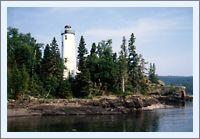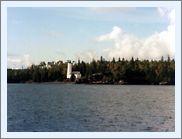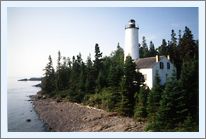|
Historical Information

Isle Royale lies out in Lake Superior some sixty miles to the north of
the Keweenaw peninsula, and a scant 14 miles south of the Canadian north
shore. It would be natural to assume that an island located so close to
the Canadian shore would be Canadian territory. However, during border
negotiations between the British and the nascent United States at the
Treaty of Paris in 1783, misunderstandings resulting from a lack of
accurate maps of the area caused the island to be included as part of
United States territory. While a number of Scandinavian fishermen would
set up operations on the island in the early 1800's, and John Jacob
Astor's American Fur Company would establish a trading post here in
1837, it would not be until the late 1840's that the United States
government would realize the windfall that resulted from the 1783
cartographic misunderstanding.
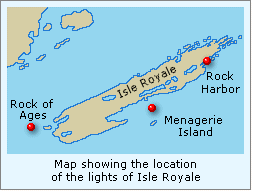 After the signing of the treaty of
LaPointe with the Chippewa Nation in 1843, Isle Royale was opened to
mineral exploration, and by 1847 more than a dozen mining companies were
working the island. Of these, the two largest were located in Siskiwit
Bay on the southeastern end of the island and at Rock Harbor to the
north. Thriving towns in the area around the mines to support the needs
of both mine and miner, and an increasing number of vessels began
arriving to deliver supplies and transport copper to the hungry
industrial centers on the southern lakes. With Congressional approval of
the new lock at the Sault granted in 1852, expectations of boom times on
Superior were high, and with this boom, maritime traffic in the Isle
Royale area was expected to grow exponentially. After the signing of the treaty of
LaPointe with the Chippewa Nation in 1843, Isle Royale was opened to
mineral exploration, and by 1847 more than a dozen mining companies were
working the island. Of these, the two largest were located in Siskiwit
Bay on the southeastern end of the island and at Rock Harbor to the
north. Thriving towns in the area around the mines to support the needs
of both mine and miner, and an increasing number of vessels began
arriving to deliver supplies and transport copper to the hungry
industrial centers on the southern lakes. With Congressional approval of
the new lock at the Sault granted in 1852, expectations of boom times on
Superior were high, and with this boom, maritime traffic in the Isle
Royale area was expected to grow exponentially.
In his annual report to the Fifth
Auditor of the Treasury for 1852, Henry B Miller the Superintendent of
lights on the upper lakes recommended that $5,000 be appropriated for
the establishment of a lighthouse at the entrance to Rock Harbor, to
serve as a guide to mariners seeking to enter that harbor. Congress
responded with the requested appropriation on appropriated on March 3,
1853. That same summer, a survey crew arrived at Rock Harbor and
selected a site for the new Light, and the process of obtaining title to
the property was begun. With title negotiations coming to completion at
the end of the year, plans were formulated to commence construction with
the opening of the 1854 navigation season.
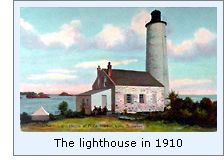 Construction appears to have began the
following year, but for as yet undetermined reasons was not completed
until 1856. The station's rubble stone tower stood 16 feet 11 inches in
diameter at the foundation, with its 49 foot 11 inch high walls tapering
gently to a diameter of 14 feet 1 inch below the circular gallery. A set
of spiral pine stairs supported by a central pine post wound within the
tower from the first floor to a trap door in the gallery floor to
provide access to the lamp. The lantern itself was fabricated of cast
iron, and featured a domed copper roof. Centered within the lantern, a
fixed white Fourth Order Fresnel lens sat at a focal plane of 70 feet
above lake level, and cast its light 15 miles across the lake The
attached rubble stone dwelling, stood 29 feet square and 20 feet 9 ½
inches high at the apex of the cedar shingled roof. Construction appears to have began the
following year, but for as yet undetermined reasons was not completed
until 1856. The station's rubble stone tower stood 16 feet 11 inches in
diameter at the foundation, with its 49 foot 11 inch high walls tapering
gently to a diameter of 14 feet 1 inch below the circular gallery. A set
of spiral pine stairs supported by a central pine post wound within the
tower from the first floor to a trap door in the gallery floor to
provide access to the lamp. The lantern itself was fabricated of cast
iron, and featured a domed copper roof. Centered within the lantern, a
fixed white Fourth Order Fresnel lens sat at a focal plane of 70 feet
above lake level, and cast its light 15 miles across the lake The
attached rubble stone dwelling, stood 29 feet square and 20 feet 9 ½
inches high at the apex of the cedar shingled roof.
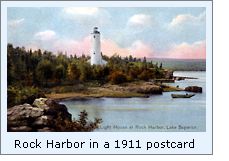 Mark Petty was appointed as the
station's first Keeper and with his brother Michael as his Assistant,
both arrived at the station on October 24, 1856, and exhibited the light
for the first time soon thereafter. After a short year at the station,
Michael passed away on July 16, 1857 and with his brother's death, Mark
resigned from lighthouse service. The Petty's were replaced by a second
pair of brothers when Francis and William Bomassa were assigned to the
station. Evidently William was ill-suited for the rigors of lighthouse
keeping on such a remote location, as he resigned his position on
September 8, 1858, leaving alone to tend the light. Mark Petty was appointed as the
station's first Keeper and with his brother Michael as his Assistant,
both arrived at the station on October 24, 1856, and exhibited the light
for the first time soon thereafter. After a short year at the station,
Michael passed away on July 16, 1857 and with his brother's death, Mark
resigned from lighthouse service. The Petty's were replaced by a second
pair of brothers when Francis and William Bomassa were assigned to the
station. Evidently William was ill-suited for the rigors of lighthouse
keeping on such a remote location, as he resigned his position on
September 8, 1858, leaving alone to tend the light.
With the closure of the mines and
dwindling maritime traffic in the area, the Lighthouse Board determined
that the Rock Harbor Light no longer served any real purpose as a
navigational aid, and the decision was made to abandon the station.
After extinguishing the light and locking the station doors, Francis
Bomassa followed in his brother's footsteps, boarded a boat, and bade
farewell to both the light and to lighthouse service on August 1, 1859,
leaving the Rock Harbor light alone to face the ravages of time and the
elements.
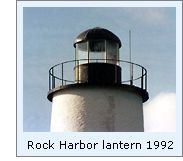 With the outbreak of the Civil War, and
a resulting increase in metals consumption, miners once again set their
sights on Isle Royale, and new and more efficient mines were established
at Siskiwit Bay on the southeast shore and McCargo Cove on the
northwest. Once again, thriving communities grew up around the mines to
support the mining and shipment of copper, and with a resurgence in
maritime traffic making for the island to transport copper south through
the Sault Locks, the Eleventh District office began to consider
reactivating the old Rock Harbor Light. With the outbreak of the Civil War, and
a resulting increase in metals consumption, miners once again set their
sights on Isle Royale, and new and more efficient mines were established
at Siskiwit Bay on the southeast shore and McCargo Cove on the
northwest. Once again, thriving communities grew up around the mines to
support the mining and shipment of copper, and with a resurgence in
maritime traffic making for the island to transport copper south through
the Sault Locks, the Eleventh District office began to consider
reactivating the old Rock Harbor Light.
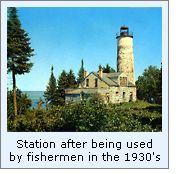 A complete examination of the abandoned
station was undertaken in 1873, and plans put in place for its
renovation and reactivation at a total cost of $5,000. A work party and
materials were delivered at Rock Harbor in late June of 1874 and a
number of improvements undertaken. The
entire building given a cement wash coat, interior walls were
re-plastered, buckled pine flooring was replaced and the roof re-shingled. A
new woodshed, boat house and dock were also built, and with a change in the
characteristic of the light from fixed white to fixed red, the
work came to an end. Acting Keeper Anthony Kruger reported to take
charge of his "new" station, and after moving into the renovated
dwelling, Kruger ascended the pine stairs in the tower to reactivated
the station's Fourth Order Fresnel for the first time on the evening on
August 5. Kruger would tend the light alone for over a year before
Acting Assistant Ferdinand Dumont was appointed to the position and
arrived at the station on October 23, 1875. A complete examination of the abandoned
station was undertaken in 1873, and plans put in place for its
renovation and reactivation at a total cost of $5,000. A work party and
materials were delivered at Rock Harbor in late June of 1874 and a
number of improvements undertaken. The
entire building given a cement wash coat, interior walls were
re-plastered, buckled pine flooring was replaced and the roof re-shingled. A
new woodshed, boat house and dock were also built, and with a change in the
characteristic of the light from fixed white to fixed red, the
work came to an end. Acting Keeper Anthony Kruger reported to take
charge of his "new" station, and after moving into the renovated
dwelling, Kruger ascended the pine stairs in the tower to reactivated
the station's Fourth Order Fresnel for the first time on the evening on
August 5. Kruger would tend the light alone for over a year before
Acting Assistant Ferdinand Dumont was appointed to the position and
arrived at the station on October 23, 1875.
 In a fateful repetition of history,
copper prices again plummeted with the end of the Civil War, and Isle
Royale's second mining boom came to a close. With the establishment of
the new Isle Royale Light on Menagerie Island on October 19, 1875, the
Rock Harbor Light's days were again numbered. Four years later, Keeper
Martin R Benson exhibited the Rock Harbor light for the last time on
October 4, 1879, and left the island for his new assignment as Keeper of
the Portage Lake Ship Canal light. In a fateful repetition of history,
copper prices again plummeted with the end of the Civil War, and Isle
Royale's second mining boom came to a close. With the establishment of
the new Isle Royale Light on Menagerie Island on October 19, 1875, the
Rock Harbor Light's days were again numbered. Four years later, Keeper
Martin R Benson exhibited the Rock Harbor light for the last time on
October 4, 1879, and left the island for his new assignment as Keeper of
the Portage Lake Ship Canal light.
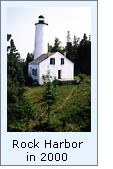 Other than being used as a base of
operations for a couple of fishermen working off the island in the
1930's when two dormers were added to the roof and the lean-to at the
rear of the dwelling was enlarged, the old station sat empty, and slowly deteriorating. With then
establishment of the Isle Royale National Park in 1939, the old
structure became a part of the National Park, however serving little
purpose to campers or the Park system, no steps were taken toward either
rehabilitation or restoration. In the late 1950's the tower began to
tilt, and fearing that the tower might topple, an emergency
stabilization was undertaken, limiting the lean to approximately two
degrees from the vertical. Other than being used as a base of
operations for a couple of fishermen working off the island in the
1930's when two dormers were added to the roof and the lean-to at the
rear of the dwelling was enlarged, the old station sat empty, and slowly deteriorating. With then
establishment of the Isle Royale National Park in 1939, the old
structure became a part of the National Park, however serving little
purpose to campers or the Park system, no steps were taken toward either
rehabilitation or restoration. In the late 1950's the tower began to
tilt, and fearing that the tower might topple, an emergency
stabilization was undertaken, limiting the lean to approximately two
degrees from the vertical.
An improved trail system throughout the
island has now made the lighthouse easily accessible, and many hikers
now take the time to visit the venerable station.

Keepers of this
Light

Click here
to see a complete listing of all Menagerie Island Light keepers compiled by
Phyllis L. Tag of Great Lakes Lighthouse Research.

Finding this Light

The Isle Royale National Park conducts a number of Ranger-led
interpretive hiking tours of Isle Royale historic sites. One such tour
out of Rock Harbor covers both the the Edisen Fishery and Rock Harbor
Lighthouse. This tour lasts approximately 4 hours, and departs from Rock
Harbor at 2.00 PM on Thursdays and at 9.00 AM on Saturdays e tours
throughout the summer season. For additional information, click
here to visit the interpretive programs section of the NPS Isle Royale
website.
Keweenaw Excursions also offers a
lighthouse cruise which passes Rock Harbor on board the KEWEENAW STAR
out of Houghton, Michigan. For more information on any of their tours
visit their website,
or telephone Keweenaw Excursions at (906) 482-0884.

Reference Sources

Isle Royale National Park, foot trails & water routes, Kim
DuFresne, 1984
Annual reports of the Lighthouse Board, various, 1878 - 1909
Annual report of the Lake Carrier's Association, 1915
Log books of the Menagerie Island Light, transcribed by Don
Nelson.
Northern Lights, Charles K. Hyde
Email correspondence with Don Nelson, various, 2002
Photographs of the station taken in 1991 courtesy of Don Nelson
Photographs of the station taken in 2000 courtesy of Wayne Sapulski
Keeper listings for this light appear courtesy of Great
Lakes Lighthouse Research
|
